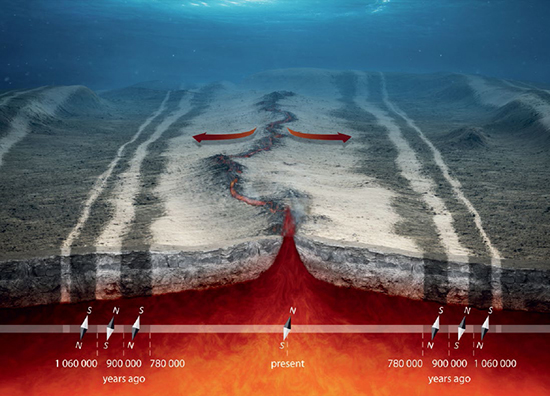1963
Reversing Magnetic Polarity
Motonori Matuyama (1884–1958), Lawrence W. Morley (1920–2013), Frederick J. Vine (b. 1939), Drummond H. Matthews (1931–1997)
Deep inside the Earth, electric currents created in the outer core—a spinning shell of molten iron—create powerful magnetic fields that form a strong magnetosphere around our planet. Earth’s magnetic field is the force that makes compass needles point to the north or south. The subfield of geophysics called paleomagnetism focuses on the study of changes in the Earth’s magnetic field over time, and on the ways that those changes can be used to better understand Earth’s surface and interior processes.
Volcanic rocks contain a small fraction of magnetic minerals, like magnetite, that, when melted, line up like little compass needles parallel to the Earth’s magnetic field. When the rock cools, it preserves a record of the Earth’s magnetic field at the time of solidification. Geologists have been studying magnetized rocks since the early twentieth century, noting reversals in the polarity (north or south) of some rocks relative to others. In 1929, Japanese geophysicist Motonori Matuyama discovered that the most recent reversal in the Earth’s magnetic field occurred about 780,000 years ago. Subsequent researchers found that Earth’s field has flipped hundreds of times since the Jurassic, though the exact cause is still unknown.
An even more important discovery was made in 1963, when two studies (one by Canadian geophysicist Lawrence Morley, the other by the British geophysicists Frederick Vine and Drummond Matthews) independently interpreted magnetic field reversals that had been mapped since the 1950s in stunning magnetic “stripes” on the seafloor. The fact that the polarity of the stripes was symmetric on opposite sides of mid-ocean ridges led them to conclude that the ridges must be the source of new molten rock being erupted onto the seafloor. The rock solidifies and preserves the magnetic-field polarity at the time, but then those rocks get carried away from the ridges and eventually new lava that erupts later can preserve the opposite magnetic polarity. Magnetic-field reversals were thus one of the keys to discovering that mid-ocean ridges are also centers of seafloor spreading.
SEE ALSO Earth’s Core Forms (c. 4.54 Billion BCE), Continental Crust (c. 4 Billion BCE), Plate Tectonics (c. 4–3 Billion BCE?), Magnetite (c. 2000 BCE), Solar Flares and Space Weather (1859), The Inner Core (1936), Mapping the Seafloor (1957), Seafloor Spreading (1973), The Oscillating Magnetosphere (1984)
As new seafloor is created by volcanoes at mid-ocean ridges, the polarity of Earth’s magnetic field at the time is recorded in magnetic minerals in the volcanic rocks. As the seafloor spreads away from the ridges, it acts like a geologic “tape recorder” to reveal changing patterns of magnetic polarity over time.
